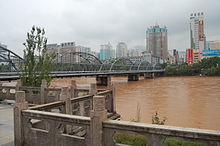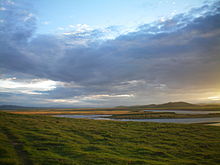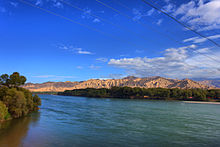Yellow River
![]()
The title of this article is ambiguous. For other meanings, see Yellow River (disambiguation).
The Yellow River, also Huang He (Chinese 黃河 / 黄河, pinyin Huáng Hé, W.-G. Huang Ho, ![]() obsolete after post: Hwang Ho, mong. Hatan Gol, abbreviated as 河, Hé), is a stream classified as a river in the north of the People's Republic of China (East Asia).
obsolete after post: Hwang Ho, mong. Hatan Gol, abbreviated as 河, Hé), is a stream classified as a river in the north of the People's Republic of China (East Asia).
After the Yangtze River, it is the second longest river in China and the fourth longest single river on earth. There are different figures for its length depending on the measurement method: 4845 kilometres is the most common figure and the one found in various encyclopaedias; the largest length mentioned in various media is 5464 kilometres. Its catchment area covers 752,443 square kilometres.
The river takes its name from the yellowish coloration caused by eroded loess, which is washed into the river course via streams and tributaries. There is a connection to the Yangtze River via the Emperor's Canal.
Source
The source of the Yellow River is located in the vast expanses of the highlands of Tibet, framed by relatively flat-looking mountains, about 200 kilometers north of the midpoint as the crow flies between Lhasa, the capital of the Tibet Autonomous Region, and Xining in the Tibetan-majority Amdo region. There it is located in the Bayankara Shan mountain range (south of Kunlun Shan) about 450 kilometers east of the headwaters of the Yangtze River, west of two lakes (Ngoring Tsho and Kyaring Tsho) and northwest of the Sea of Stars (Xingsuhai) - a rocky steppe-like area.
River
From its source, the Yellow River first crosses the two lakes Gyaring Tsho (Tsaring-nor) and Ngoring Tsho (Ngoring-nor) (34° 55′ 19″ N, 97° 30′ 43″ E34.921966666797.5119). It then flows mainly eastward under the Tibetan name Ma-chu (Tib. རྨ་ཆུ་, "River of the Peacock"; Chinese 瑪曲 / 玛曲, Mǎqū) in a zigzag course through a strongly winding high mountain valley, not far from the sacred mountain A'nyê Maqên.
Its further course then leads northwards, where it advances to the borders of Inner Mongolia. There it describes a huge arc around the Ordos Plateau until, now flowing south again, it flows into the reservoir of the Sanmenxia Dam. In this lake, the Wei He flows into it from the region of the ancient imperial city of Xi'an; this is the largest tributary of the Yellow River.
North of the Funiushan Mountains, it turns 90° to the east. From there, the Yellow River flows consistently eastward across the Xiaolangdi Dam, crossing a loess plateau in Shaanxi and Shanxi provinces and gradually leaving the gorge-rich mountainous region.
About 45 km after the city of Kaifeng, the river turns northeast and flows through the lowland formed by its sediments. Just over 500 km beyond Kaifeng, the Huáng Hé reaches the Gulf of Bohai, a marginal area of the Yellow Sea, between Tianjin and the Shandong Peninsula.

Hukou Falls, near Xi'an - bottleneck at the knee of the Huanghe River

Yellow River in Lanzhou with Zhongshan Bridge

First big bend of the river at Maqu

Yellow River near Guide (Qinghai)
Search within the encyclopedia